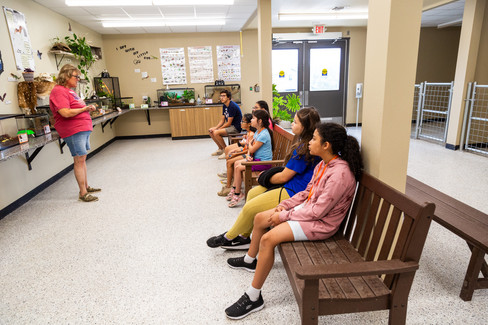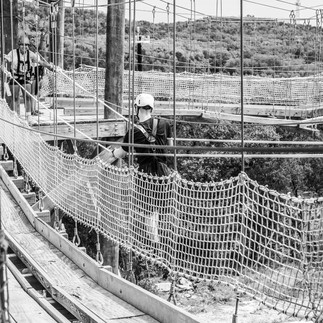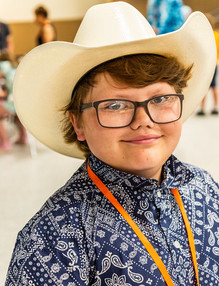SRNA Quality of Life Family Camp
- Sandy Siegel

- Apr 6, 2024
- 17 min read
The international headquarters of the Siegel Rare Neuroimmune Association is my home. For years, Pauline’s and my home telephone number was listed on the National Institute of Health, the Christopher and Dana Reeve Foundation and many other health-related web sites. If people searched for one of our disorders, they found our telephone number and called. We received phone calls from all over the world both day and night. We answered the telephone in our kitchen for years to offer information and support. The result was that Pauline and I were learning about our community in the most intimate and intense ways. We quickly figured out that children with these disorders experience a unique set of challenges that do not occur in the same way as adults. We decided that we needed to do something to address these concerns.
I decided in around the year 2000 that we should have a special program focused on families and children with these disorders. It can happen to children as young as 4 months old. They can become paralyzed before they’ve even had a chance to walk. It sucks mightily. The symptoms of these disorders (Acute Disseminated Encephalomyelitis, Acute Flaccid Myelitis, MOG Antibody Disease, Neuromyelitis Optica Spectrum Disorder, Optic Neuritis and Transverse Myelitis) can be weakness to paralysis, spasticity, neuropathic pain, depression, fatigue, bowel and bladder dysfunction, and vision impairment to blindness. What happens to adults can be tragic. What happens to a child because of all the developmental issues can be so much more than tragic.
I started raising money. I found a hotel willing to work with me. I started inviting our experts to conduct a two-day education program for the parents. We had physicians attend from the Transverse Myelitis Center of Excellence at Johns Hopkins and I also had many medical professionals from Children's Hospital. I arranged for Columbus School buses to take the younger children to the Columbus Zoo on one day and to the Center of Science and Industry on the next. We put together a teen adaptive recreation program with the help and participation of the Physical Therapy Program at Children's Hospital and the Columbus Parks and Recreation Department, Adaptive Recreation Program. It was all hands-on deck. Everyone volunteered their time. I matched an adult (the husbands and wives of the medical professionals) with each of the children for the outings. Most of the TMA officers came to assist. We got various local companies to donate the lunches. My children also got involved. Aaron and Hanni were matched with children for the two outings. David and Pauline ran the teen recreation program. My brother and sister also came to help. My brother was a presenter in our education program (he's a pediatric clinical psychologist) and my sister (who is an occupational therapist) was able to help with the children. I invited a librarian with transverse myelitis to attend. During breaks she read to the younger children and played guitar. She was in a conference room with the children. We covered the floor with mattresses. We had an art therapist work on a project with the children. There was a pool in the hotel and the families went swimming at night.
The family workshop was held in 2002. I worked every day for more than a year to put the entire program together, and I was able to raise enough money that the families only had to pay to get to Columbus and their hotel fee. And I was able to get the hotel to offer an excellent price for the rooms. I had a volunteer nurse who went out with the children on these adventures so that they could receive their medications during the day. All the medical people volunteered their time and traveled on their own dime. The entire process was totally insane. On the first night at our opening dinner, I started presenting the logistics of the weekend, and as I listened to myself describing the complexity of this whole gig, I stopped mid-sentence and uttered aloud, how in the hell are we going to do this? Well, we did it, and it was remarkable.


It was the first time these children ever met another child with their disorder. It was the first time parents met other parents. These families are forever connected and remain friends to this day. Pauline and I both cried many times throughout the weekend. I’m so glad our own family was involved. When it was all done, Pauline told me that I had just pulled off one of the most miraculous events possible, that she was proud of me and that I was never allowed to do it again. I agreed. I had devoted an entire year to making it happen and I was able to do little else.
There was a group of mothers from our community who volunteered to help me find a medical camp. My plan was to find an accessible camp with an accessible recreation program. We would bring our doctors to conduct the education program and would invite the families from our community.
In 2005, one of our mothers found Victory Junction Gang Camp in North Carolina. I met with the camp director and medical director and pitched a camp for our community. Their summer camp did not include families. They had children with certain disorders attend for the week of camp. We were asking for something entirely different; for them to work with an organization and to have a camp focused on our rare disorders. And we were asking them to include our education program. The pitch was … you offer the facility and your camp program; we’ll bring the families and the medical professionals to conduct the education. They loved the idea. We started offering a teen and young adult weekend in the fall and a summer camp for the families. This camp is one of the Paul Newman, Hole in the Wall Gang Camps and it is the Taj Mahal of medical camps. So many of our medical professionals wanted to attend that we had to start limiting the numbers. Our families absolutely loved the camp and our program.
All was wonderful until it wasn’t. Personnel at these camps change frequently. These are difficult jobs and as with most not-for-profits, the pay isn’t always the best. So, we started dealing with new people who were not part of our original arrangement. And so it goes. It was one of many disappointments I experienced along the way with getting our families to camp. But early on I understood that this whole thing was not about me ... It was all about our children and families. So, I picked myself up (after crying), dusted off, and got on with the mission.
In 2011, Pauline and I met with the director and medical director of the Center for Courageous Kids in southern Kentucky. I made the same pitch I’d made in 2005 and they loved the idea. They were in the same position. They’d never worked with an organization that brought families into camp and they didn’t offer any kind of education programs. They loved our ideas, and we began our camp there in the summer of 2011. It was a wonderful experience for our families and our medical professionals.




Covid was a tough period for us. No camp.
Last year we began our camp at Morgan’s Wonderland in San Antonio. The children with these disorders have so many challenging medical issues. Bringing people together also meant a risk of spreading Covid, which these children need like a hole in the head. So, we had to create a set of guidelines and protocols for how to get families together. It worked well. Our numbers were smaller than they usually are because families are rightly being cautious about traveling and getting together in large groups. In time, our numbers will get larger.
We are a rare disorder community, and we are a small organization. We do so much of our work virtually; our community doesn’t get together frequently. So, when we do get together, I’ve got my camera and I’m going to be shooting the crap out of the event. My work is documentary photography. It helps that I'm a cultural anthropologist. I know how to tell a story and I know how to tell a story with my images. After going to college for 14 years to become an anthropologist, it's nice that my training and experience is good for something. My images are used for our publications, including our electronic media, and for our awareness and fundraising. It is important work.
I used to be the person who did all the planning and coordination for our camp. One of our staff has taken over this responsibility. She intimately understands the importance of camp, as she has come to camp with her family and her child with TM. There aren’t a lot of people who I would entirely entrust to do this work. She’s remarkable and I have totally handed over the keys to the kingdom. Rebecca does it all. Our version of the 2023 Siegel Rare Neuroimmune Association Quality of Life Family Camp was spectacular.
Morgan's Wonderland was beautiful. Oak trees in Texas are very different from the varieties we have in Ohio.
I did more with black and white photography from this camp. I always shoot in raw and color. When I am shooting camp, and other events for the SRNA, I take multiple shots to be sure that I capture a good portrait or an important activity. If more than one of the shots is good, I'll work one of them in color and the other in black and white. From this camp, I was really pleased with how many of the black and white shots turned out.

Most of our wonderful SRNA Staff attended. We also had exceptional volunteers. Many of the volunteers have one of the disorders. Some of them have attended our camps as young children. We had a wonderful group of medical professionals at camp. These medical people are among the busiest people I know. They have clinics that offer care to patients from our community, they are academicians training the next generation of neuroimmunologists and they are performing critical research. That they generously donate their time, energy and expertise is a humbling proposition for me, and they've been doing it since 2002. The families loved our staff, our volunteers, and our medical folks. I am personally grateful for all of them!
As some of our volunteers have the same disorders as our campers, they are excellent role models. I vividly remember speaking to the parents at one of the education sessions in 2002. So many of the children who attended in Columbus were just toddlers. I told the parents that their child was going to grow up to have a career, they're going to meet someone, fall in love and start a family. They are going to have lives like all of us. I was crying during this talk and so were most of the parents. As it turns out, I've watched these children grow up, and I was right. We love to bring in volunteers who can show the children and the parents all of what is possible, and it is all possible!
This is a photograph of our staff, the volunteers and some of our medical professionals.

This is our staff and volunteers preparing for the arrival of our families. It's a complicated process, but our staff is on top of it - getting everyone tested for covid, getting the families placed in their cabins, introducing them to the campgrounds and providing them with the camp schedule for the week. And answering all the questions the families are going to have.

Our staff and volunteers arrived at camp the day before the families. We were given the opportunity to learn about camp and to settle in and prepare for the arrival of our families. In the evening, we piled into a people-mover and taken down to an area to try out some of the activities. It was an opportunity for me to take some portraits of our volunteers, as well as to become familiar with some of the activities I would be shooting during the week. I love this backlit, black and white image of our crew (if I don't say so myself).


Janet is a nurse from Kennedy Krieger Institute. When Dr. Kerr established the TM Center at Johns Hopkins, he began to refer patients with ADEM, NMOSD and TM to KKI for rehabilitation. When Dr. Kerr announced his specialization in TM, he began to quickly attract patients from all over the world. As he was gaining experience, he was learning more about these disorders. The same phenomenon was occurring at KKI. As they were seeing more patients with our disorders who were being referred by Dr. Kerr and his colleagues, they were gaining valuable experience regarding the most effective rehabilitation strategies. Janet has been involved since the beginning. She has been a regular at our camps and has participated in our education programs. Through her familiarity with our program, we've asked Janet to lead the education sessions, and she has graciously done so for many years.
Eric is a children's author and educator. Eric and I have been friends since we were four years old. We met at nursery school and our families moved across the street from each other in Cleveland Heights (you know, the home of Taylor Swift's boyfriend). We went through elementary school, middle school, and high school together. After graduating, we both attended Miami University and lived in the same dorm our freshman year, and the same house our senior year. Our parents were also close friends. He's more family than friend.
When our staff was searching for a children's author to write a book about the AFM experience, I asked them to talk to Eric. They loved his work and his vision for the book. Eric co-authored No Time for the Moon https://wearesrna.org/no-time-for-the-moon/ with his partner, Diane, who is a psychiatrist. They interviewed children with AFM to learn about the experience, and as some of those children were going to be at camp, we invited Eric to participate as a volunteer. It was wonderful and very weird to have Eric share this experience with me. I was so grateful that he was able to come to camp and to meet the special people from our community.

Maria attended our camps as a child. I've known her for a long time. It was her mother who found Victory Junction Gang Camp, and who introduced me to their medical director. It was so incredibly special to have Maria come back to camp as a volunteer. She is an exceptional role model for these children, and a demonstration of hopefulness for the parents. She and her partner spent some fun time with the families.

Hannah has also come to camp with her family as a camper. She's been through some really challenging experiences. She has generously shared her experiences at some of our education programs. These are such critical programs, because they offer valuable information, and they provide support to others by demonstrating that they are not alone. She was recently accepted into medical school and will be starting this year. (And I am hoping that she will specialize in neuroimmunology, because no one could know it better than she). Whatever she decides to do, she knows I'm going to be one of her most enthusiastic cheerleaders.

The volunteers had the opportunity to ride on this thing. Morgan's Wonderland Camp brings in their own crew of volunteers who manage all the activities. Their volunteers were excellent, and we so appreciated their interactions with our families.

While I have a monumental case of acrophobia, I decided to go on this thing so that I could capture these shots of camp. It was an important perspective. Sometimes one must just suck it up to be a decent documentary photographer.


Our camp was held during the first week of July and it was hot. Fortunately, some of the days were overcast so it wasn’t as bad as it could have been. When families were going to activities across camp, they were able to take a people mover to their location. Whenever I saw families, volunteers, and medical folks ready to board, I quickly organized a group photo. So many photo opportunities, so little time.


As noted, it is a large camp. Families and volunteers engaged in lots of important conversations moving between activities, meals at the dining hall and their cabins.
I was so grateful to have a golf cart for the week at camp. There was no way I could cover camp with my knees; I had to be everywhere all at once. These are children from one family. On the first day of camp, they were so shy that I could hardly get them to look at me. By the second day, we were best friends and they hired me to be their personal shlepper. And I loved it! As I moved between sites, I often picked up people who looked like they could use a lift. When we were moving large groups between activities, I often made many trips to help. As noted, it was really hot outside (around 100 degrees). Heat is not a friend to people who have demyelinating disorders.

This is a very common site at camp; our medical professionals in conversation with our families. As these disorders are rare, many families receive clinical care from physicians or therapists who do not have a great deal of experience with neuroimmune disorders. The parents often discuss concerns they have about their child. These can range from symptom management to accessibility issues at school. Our medical folks are able to share expectations and give them information and ideas to address with their physicians and therapists at home. We've learned over the years that these conversations are incredibly valuable.

The interaction between our volunteers, staff and families goes on all week. These bonds do not end when camp is completed. These are often the beginning of friendships that continue after camp.
Interaction between the parents is one of the most important activities of camp. Having a child with one of these rare disorders can be a frightening and isolating experience. They learn so much from each other and there is so much support offered. Many of these folks become friends for a lifetime and continue to depend on each other for information and support.

Our education program took place in the afternoon on two of the days of camp. There were different physicians and therapists involved in each session. At our early camps, our medical folks made presentations to the parents. Our education programs have evolved into more of a dialogue. The presentation portion of the session is usually long answers offered to complex questions. Otherwise, these sessions have become more of a conversation with information and learning taking place in both directions. The parents learn an incredible amount about their child's disorder and the physicians and therapists learn from the parents' experiences and perspectives. This is a rare and important opportunity for the medical folks to be with their patients outside of the clinic.
There are so many wonderful and fun activities at camp. The day begins for families with dancing after breakfast.




On the first night of camp, we convened for music, dancing and making smores.
On the second evening, the camp volunteers put on a carnival with all sorts of games. And of course, there was more dancing.
There are a lot of arts and crafts opportunities going on all week, including photography in an editing studio.

There is a nature center where the families can learn about animals that are found in this region of the country. The nature center is air conditioned; an important stop to cool off after being outdoors in the Texas heat.
The archery facility was excellent.

There was a beautiful swimming pool and a 'lazy river.' The families spent lots of time in the pool. When a person has significant muscle weakness or paralysis, water can be a wonderful thing. Pauline loved being in the water. Because of buoyancy and the lack of gravity, a person has more mobility in the water. Also, if a person has uncomfortable nerve sensations from the neurological damage, they can also experience some relief in the water. But at the end of the day, the children just love playing in the water. And on these sweltering summer days, the parents loved being in the water, as well.
The swing was a fun activity. All the volunteers and families chip in to pull the swingers up as high as they want to go.
There were many ways to tackle the ropes course, even while in a chair.

Regardless of ability, if you want to go up the climbing wall, they're going to get you up. This courageous child's brother climbed next to her to help her to feel safe.
The children loved the horses and horseback riding. Many of our children do equine therapy to help with trunk strength ... and it is just fun. The horses were beautiful, and the families loved spending time at the stables.
And there were other ways to appreciate these beautiful creatures besides getting up onto the saddle.

We had some karaoke sessions, and I might have had more fun than the kids. We sang everything from In-A-Gadda-Da-Vida to Jesus Loves Me. And of course, more dancing.
We've had a talent show at every camp. What I love most about the show is that we get to see not just the incredible talent these children possess, but also the self-esteem and self-confidence that they exhibit to get up on a stage and dance, sing, do comedy, or participate in a skit. They do everything with unabashed enthusiasm. I love that beyond words. They'll never perform before a more supportive and loving audience. Watching what these children do and how they do it gives me the greatest hope that they're going to grab life by the tail and live their lives in just the ways they want.

This family, along with volunteers, performed a Barbie skit to one of the songs from the movie. I wish I could post this as a video. I laughed so hard that it was difficult for me to take the photographs.
And I also wish that I could post this as a video with the music to which she danced. She dances in a group, and she is way more than exceptional. I took all these images through my tears. It was such a brilliant performance.
The last night at camp was the Fourth of July. The children got sparklers, they had treats and there was a fireworks display.

What I love about these images is that they communicate how quickly and easily the families begin to mix with each other from the very first day of camp. Most of the children with the disorders come from a place where they know no one else who has their disorder. Many of them don't know another child from home that is in a chair or walks with a cane or walker or uses orthotics. There's no self-consciousness at camp because everyone knows and understands. Adults, children, siblings ... there is a warm and supportive interaction between everyone. Our camps are a place where these children can just be children. They can participate in every activity, which is ordinarily not the case. Some of them go to schools that are not accessible. Our camp is really a beautiful thing.
Siblings. What I have learned over the past 30 years is that if you have a child with one of our rare neuroimmune disorders, it is going to impact everyone in the family. As hard as parents try to keep their attention to all their children balanced, it is an impossible task. There are too many medical problems, too many appointments, too many emergencies ... it is way more than a challenge. The siblings have to take on responsibility at an early age. I see it at every camp, and I am always amazed by how much they love their brothers and sisters and just how resilient they are in the face of these challenges. Family dynamics are complicated where there are no health issues involved. For families trying to manage the medical, social, and financial issues that come with these disorders, all of this becomes more than complicated.

I do my best during the week to take as many family photographs as possible. I've been told by some of our families that they count on camp to get their annual family photograph. I love that I can do this for them.
It was wonderful for us to be able to share in this special birthday during camp.

This family has been coming to camp for years. They started a foundation to raise money for our cause and they always contribute to help us with our camp. We are so grateful.

My favorite photographs are the portraits I take of these beautiful children. They know me and they always offer me the loveliest smiles. I don't even have to ask.
We had families come from across the country. One of the families came from England. Over the years we've had families attend camp from almost every state in the US (including Alaska), from countries all over Europe and from as far away as South Africa, India and China. When you have a child with a rare disorder and there's an opportunity for you to learn something about it from experts, and you can meet other families going through the same experience, you do your best to go. Depending on the amount of money we can raise, we've offered travel grants to families to help them get to camp. With the money we raise, we cover all the costs of camp except for travel. The more we raise, the more we can do for these families.
If you would like to help us with camp, I would be so grateful. You can designate your donation for camp on our web site.
I don't see most of our donations. Everything used to be mailed to my home (the international headquarters). Now our donations go directly to the bank. If our staff can figure out that the donation is coming from a friend or family member, they let me know so I can thank them personally. They can't always figure out the connections. So, if you donate and I don't see it ... THANK YOU! I so appreciate your support - and so do our families.
Along with the James T. Lubin Fellowship, the SRNA Quality of Life Family Camp is the best thing that Pauline and I were able to accomplish. I know how proud Pauline was of both programs. When Pauline came to camp, she was quite literally the Queen of The Transverse Myelitis Association.

































































































































































































































































































































Comments